NEW ORLEANS: THE CAPITOL OF CREOLE CUISINE
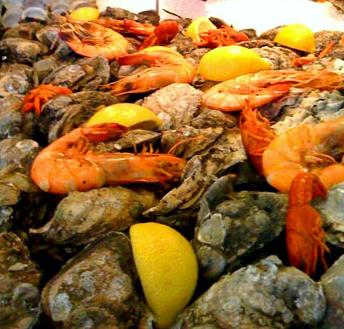 We are taking a peek at New Orleans in late 2009, when it is finally emerging from the devastating floods caused by the levies collapsing after hurricane Katrina hit the metropolis head-on, and destroyed a good deal of the city. All major hotels, except for the Hyatt, have now reopened although, there is still a great deal of work to be done in the private sector. The people have galvanized in an effort to help each other, but sadly some businesses and restaurants never reopened.
We are taking a peek at New Orleans in late 2009, when it is finally emerging from the devastating floods caused by the levies collapsing after hurricane Katrina hit the metropolis head-on, and destroyed a good deal of the city. All major hotels, except for the Hyatt, have now reopened although, there is still a great deal of work to be done in the private sector. The people have galvanized in an effort to help each other, but sadly some businesses and restaurants never reopened.
The city of New Orleans is the nucleus of Creole and Cajun cuisine which, is a highly respected form of cooking and enjoyed by many devotees. Personally, after many visits to this charming city spanning several decades, I find Haute-Creole food served in the city’s most esteemed restaurants to be generally heavy and clumsy. The use of roux, cooked until chocolate brown and used freely in almost everything, is appalling to me. The French gave up this style of heavy-handed cooking years ago and adopted to reduce sauces rather than adding roux. Fortunately, the first glimmer of this lighter, healthier style of cooking is starting to become evident in the menus of many of the new restaurants beginning to spring up around the city.
It is difficult to make the differentiation between Creole and Cajun, as there are so many similar influences in their cultures although, following is a brief attempt to summarize them.
Creoles
Creoles were descendants of the first French settlers in the colony of Louisiana and took the name to distinguish them from recently landed French immigrants.
The Creoles that live in New Orleans are light-skinned blacks or mulattos while French-speaking blacks from small towns in rural Southwest Louisiana are called Creoles to differentiate themselves from French-speaking whites called Cajuns, (Arcadians) that came from Nova Scotia by way of France.
The Creole lineage comes from Africa, Europe and the French Caribbean although, some whites in South Louisiana describe themselves as Creole but do not like the affiliation with Africa.
Cajuns
Forcefully expelled by English troops from Acadie, Nova Scotia in 1755 these people finally settled in southwest Louisiana and intermingled with French, Spanish and Germans already established there. They lived in the bayous and marshes and, over time, borrowed much of their culture from their black Creole neighbors. The mix of these different nationalities created a new group—Cajuns.
The basic Creole dishes are:
Gumbo, a spicy soup consisting of crab, shrimp, oysters, chicken, sausages, ham and seasonings, simmered in a thick broth, roux and filé.
Crawfish Etouffe, a delicate combination of crawfish tails, onions, green peppers and spices in a flavorful sauce, served with buttered noodles
Shrimp Clemenceau, shrimp sautéed in garlic butter, mixed gently with garden peas, potatoes and mushrooms.
Jambalaya, a seasoned rice, shrimp, and sausage mixture served as a compliment to many Creole dishes.
Veal is the mainstay of all Creole kitchens as the pungent Creole sauces can enhance its mild flavor.
Court Bouillon is also important to Creole cooking, it is a combination of flavorful fish and Creole seasonings that together produce a unique taste sensation.
I am going to start off by saying, try to avoid all the popular tourist dining spots such as: Antoine’s, Galatoires, Arnaud’s, Commander’s Palace, Brennan’s; all are New Orleans restaurants serving bastardized French cuisine however, I realize that if you have never tried this type of cooking, if you are in the least bit inquisitive, you will probably not be able to resist at least trying it. After all, this is New Orleans and you must try their famous cooking, Right?
THE FRENCH RESTAURANTS
The Le Meridian Hotel at 614 Canal Street had a very good “strictly French” dining room, before it was taken over by J.W. Marriott Hotel which offered another choice of proper French cuisine in the city.
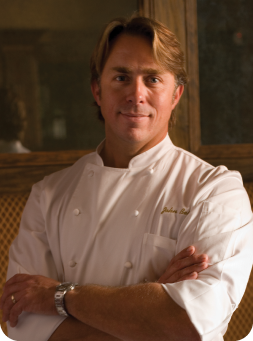 La Provence
La Provence
French
25020 Highway 190, 4 miles East of Mandeville
504-626-7662, 504-626-9598
Credit Cards: All Major
Prices: Expensive
It is certainly worth the forty-minute drive over the causeway across Lake Pontchartrain and through a State Park to visit one of New Orlean’s best restaurants, La Provence. Surrounded by pines and oak you might think you were in the heart of Provence in France; the building reminds one of similar structures in Aix en Provence or St. Tropez.
When Chris Kerageorgiou, the original owner passed away, his former chef de cuisine John Besh took over the restaurant from his fallen mentor. Besh is already a well known and popular Chef in New Orleans.
The wine list is as good as any list in this part of the country and is collected with understanding with a solid base in wines from the southern part of France that lend themselves to this climate so well.
The cuisine is based on recipes from that part of France and is mainly good, it probably would be close to perfect if the kitchen was not dealing with the American palate. With the exception of a slightly overcooked Gigot d’Agneau (Leg of Lamb) were all outstanding. It is interesting to note that no salt appears on the table—I approve.
Saucisse Merguez, North African lamb sausage; Quail Gumbo (a creation of the late owner Chris Kerageorgiou); Rabbit (his mother’s recipe); Menu á prix Fixe.
Wines: Ch. Roubine Côtes de Provence, Cru Classé, a delicious wine from the Maures Hills behind St. Tropez available in white, rose and red. Domaine de la Gautiere, Bandol Ch. De Pibarnon light, drinkable and reasonably priced wines from the South of France.
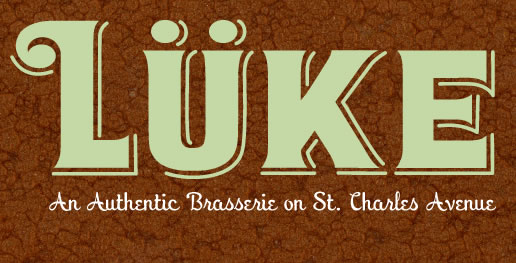 Lüke
Lüke
American Brasserie
333 St. Charles Avenue
504.378.2840
Credit Cards: all Major
Prices: Moderate
At John Beck’s Lüke, a melding of Alsace and New Orleans recreates an old-fashioned brasserie albeit more American in style than anything else, weighted toward big portions and well prepared everyday food. Everything from charcuterie to duck cassoulet with sausages; to a hamburger with fries and local fish bathed with French Meunière sauce, and of course, the de rigueur selection of raw shellfish.
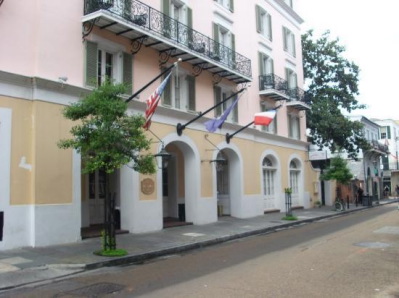 Louis XVI
Louis XVI
French
St. Louis Hotel
730 Bienville St. (between Royal & bourbon Streets)
504-581-7000
Credit Cards: All Major
Prices: Expensive
It appears that the restaurant is no longer open in the evening and the hotel has fallen into disrepair.
Louis XVI is situated on Bienville Street in the lovely, old St. Louis Hotel. The restaurant is accessed through a tranquil and well-landscaped courtyard with a statue in its center.
The atmosphere is too cold and the wait staff has too much pomp and stuffiness for its own good and it gets in the way of smooth, seamless service.
Our waiter approached the table and announced that his name was Dwaine and that he would be assisting the Captain, Rene, tonight. A while later, Rene stopped by the table and introduced himself. As the evening progressed, he repeated his name on two other occasions, prompting one of our guests to ask his name one more time, in jest of course.
The menu lists all the standard French fare with a sprinkling of Creole favorites. A rack of lamb when sliced was rosy pink and other dishes ordered came out properly presented, and without any real complaint to register, I felt that the wine list could have had more interesting selections in the middle ground and that the cooking—just had no oomph.
Bizou (Now Closed)
French/Creole
701 St. Charles Avenue
New Orleans, LA 70130
504-524-4114
This was another authentic “strictly French” restaurant that I enjoyed, but Bizou is no longer in existence, and Daniel Bonnot is filming TV spots for “Great Chefs” and is now teaching cooking in an 18th century farmhouse in Provence, when he is not teaching in France he is in New Orleans. Chef Daniel Bonnot, of Chez Daniel, on the outskirts of New Orleans in Metairie, moves into the city to open this new informal restaurant. Picture windows overlook the street corner in this St. Charles Street café and brown and white-striped chair covers add a funky look to the otherwise minimalist décor.
Starters: Boxed Sushi of Smoked Salmon, Crab, Tobiko Caviar with Traditional Garnishes; Corn Fried Oysters with a Spicy Ginger BBQ Sauce; Crawfish Beignets.
Main: Seared Veal Chop over a Three-Bean Cassoulet; Marinated and Grilled Pork Tenderloin with Cheddar Grit Cakes, Braised Greens and a Southern Comfort Demi-Glace.
Crozier’s (Now Closed)
French
3216 W. Esplanade Ave. N. (Causeway Blvd.), Metairie
504-833-8108
Unfortunately, the Crozier’s sold their restaurant and opened Chateaubriand Steakhouse that was badly damaged by the resulting flood caused by the hurricane and never reopened. Sadly, Gerard Crozier passed away recently around October, 2009.
Crozier’s was exposed in the middle of a dingy strip mall next to a mail box rental place and it looks terribly out of place. This restaurant’s façade, and for that matter its interior, was nothing to look at although, what you found after you were comfortably seated, was straightforward, old-fashioned classic French cooking. Dishes such as Chateaubriand with Bearnaise Sauce (on this occasion tomato puree was added, so, it was actually a Sauce Choron) may seem outdated, but the owner uses the best possible ingredients and the dishes are presented with perfectly concocted sauces and everything is prepared with caring effort.
A perfect small appetizer of crayfish tails sautéed in garlic was followed by a light salad followed by the above mentioned Chateaubriand for two. Other old standbys included Coq au Vin, Filet au Poivre, and Escargots.
THE CREOLE RESTAURANTS (IF YOU MUST AND YOU PROBABLY WILL)
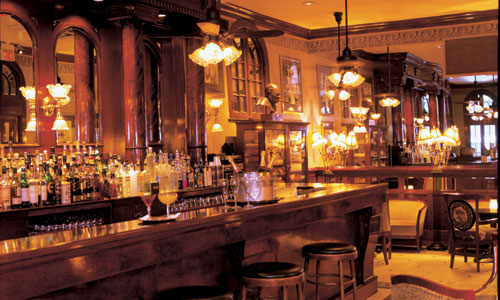 Arnaud’s
Arnaud’s
Haute Creole
813 Bienville St. (between Bourbon & Dauphine Steets)
504-523-5433
Credit Cards: All Major
Prices: Expensive-Very Expensive
Arnaud’s, since 1918 the Grande Dame of Haute Creole, has many ventures along one side of Bienville Street. Arnaud’s French 75 Bar, Arnaud’s Jazz Bistro and Arnaud’s Dining Room stand side by side. Inside Arnaud’s dining room the service staff strut around dressed in stiff, penguin-like garb and the walls are wood paneled—they give an air of elegance.
Unfortunately, the food was disappointing. Things began badly with one of their signature dishes, Crawfish O’Connor, a salty, dry, bowl of crayfish barely moistened by an over-reduced sauce and a Shrimp Bisque containing rubbery bits of shrimp in an overly salty, floury soup. Pompano Duarte with shrimp, tomatoes, garlic, fresh herbs and crushed chili peppers fared better but a Seafood Gumbo was heavy and pasty. On the brighter side a Sazerac cocktail (Peychard’s bitters, Angostura bitters, rye whiskey, dash absinthe substitute and lemon peel) was made properly, and not too sweet as encountered elsewhere in the city.
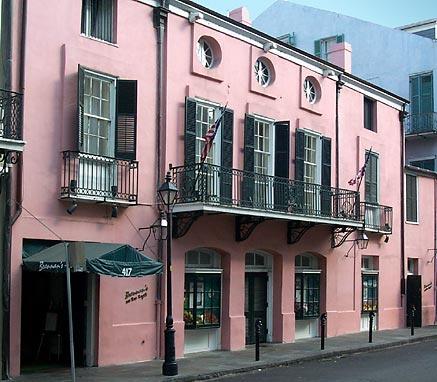 Brennan’s
Brennan’s
Creole
417 Royal St. (between Conti & St Louis Streets)
504-525-9713
The original Brennan’s restaurant, and still a charmer, set in a typical French Quarter, two-story building with high ceilings and oversized doors and balconies with fancy iron railings.
The best, ice-cold, Ramos Fizz imaginable (gin, white of egg, half & half or cream, lime juice, lemon juice, sugar, orange flower water, vanilla extract) can be found here although, a Mint Julip (muddled mint, sugar syrup, bourbon and shaved ice) was so sweet as to render it undrinkable.
The service is painstakingly slow and the waiter forgot some items ordered. Their signature dish, Eggs Sardou, was made with salty, canned spinach and canned artichoke hearts and Eggs Benedict were sitting on top of an inedible round of dried, salty pressed meat of unknown origin. And both of these eggs dishes cost an outrageous $24 each.
The famous and widely copied Bananas Foster (bananas and brown sugar, flamed with rum and served with vanilla ice cream) was first made for Richard Foster, a friend of restaurateur Owen E. Brennan, in 1976.
Dooky Chase
Creole
2301 Orleans Ave. (Miro St.)
504-821-0600
Now only open for lunch Tues-Fri., and as they have odd opening hours I would advise a telephone call to see if they are open.
This Creole restaurant was opened in 1941 by Edgar “Dooky” Chase Sr. and is now operated by his son “Dooky” Chase Jr. and wife, Leah Chase. It has become an important institution in the black community, and has an extensive collection of primitive black art that decorates the walls and a brightly colored glass mural behind the lunch buffet.
Dooky Chase is probably one of the best places in the city to sample Creole food at its best and a stop here is almost mandatory.
Red Fish Filet cooked in a Court Bouillon with tomatoes, Green Peppers, seasonings and served with steamed rice; Breast of Chicken a la Dooky stuffed with Oyster Dressing and baked slowly in Marchand du Vin Sauce; Jambalaya and Creole Gumbo.
Emiril’s
Creole/New World
800 Tchoupitoulas St. (Julia St.)
504-528-9393
Credit Cards: All Major
Prices: Expensive
I considered myself extremely fortunate to be able to pull two of the ten or so seats at the Chefs Bar in Emiril Lagasse’s cold—and even colder temperature—converted warehouse. The amusement of watching the chefs “do their thing” in front of the line, just a couple of feet from our seat, is exciting at the onset, although as time progresses it becomes difficult to determine which dishes correspond to the written descriptions on the menu. Therefore, confusion sets in, and, it is difficult to find the name of the dish that looked so good as it was being prepared. After being covered with Cajun spices or heavily paneed it is almost impossible to tell meat from fish or pork from veal. All ingredients are piled onto the plate in huge heaps. My companion’s heap of Andouille Crusted Texas Redfish with Shoestring Potatoes, arrived by way of the line in the large kitchen to the rear, looking sad and wilted. The rare steak that I had ordered was delivered medium and glazed with a poor quality blue cheese and thrown onto a pile of sour cream mashed potatoes.
This is one of the “hottest” restaurants in New Orleans and it is really difficult to obtain a reservation, but in all fairness, the food comes off a factory assembly line and the result is clearly “commercial fodder”. I paid the bill, we left the food; we left the restaurant, and went on to greener pastures!
BARS
Arnaud’s French 75 Bar
813 Bienville Street
Sazarac Cocktail
Much of the carousing in New Orleans involves wandering around Bourbon Street sipping a Hurricane from Pat O’Brien’s, which you might do once. However, it is a must at some point to retreat to Arnaud’s French 75 for the city’s official cocktail: The Sazerac. This famous drink was developed in the mid-1800s at a French Quarter coffeehouse of the same name; it was originally made from absinthe, brandy and a smidge of Peychaud’s bitters, but due to a later brandy shortage, rye whiskey was substituted. The herbal concoction is heavy on anise, slightly medicinal and borne from a complicated preparation: a chilled glass of rye, bitters and simple syrup is strained into another chilled glass coated with a swirl of absinthe, recently legalized again in the U.S. and elsewhere.
Windsor Court Hotel Bar
300 Gravier St.
504-523-6000
The Windsor Court Hotel, the best hotel in New Orleans, has an extraordinary bar located on the second floor that is an elegant and fun place to have a drink at cocktail time and features a piano player. Another option is the lobby bar on the ground floor.
Pat O’Brien’s
624 Bourbon St.
504-561-1200
Granted, it is as commercial as it gets, but it has been part of the New Orleans scene since 1933, home of the world-famous Hurricane and is touted to do more volume for its size than any other bar in the world.
JAZZ
Donna’s
800 N. Rampart St., New Orleans, LA 70116
504-940-5442
Donna Poniatowski Sims & Charles Sims own a jazz club featuring many interesting artists throughout the year. Of interest to the hygienically minded do try to avoid the loos, but after all it is all in the spirit of things.
Snug Harbor, Jazz Bistro
A small restaurant up front and the jazz club in the rear. Always good groups are booked here.
Preservation Hall
726 St. Peter St.
504-522-2841
Open 8pm
Admission: $5.00
You probably will have to stand in line and once inside it is standing room only. Check the papers for the program of who is playing. It is always guaranteed to be good.
House of Blues
225 Decateur St.
504-529-2583
A relatively new arrival on the scene and they are packing them in. Restaurant, VIP room, and many bars make this place one of the most comfortable place to hear good jazz in town.
Maxwell’s Jazz Cabaret
615 Toulouse St.
504-523-4207
PLANTATIONS
Oak Alley Plantation
One hour from New Orleans by I-10 to Gracercy, Exit #194
3645 Hwy. 18, Vacherie, LA
504-265-2151, 1-800-442-5539
Overnight Cottages
Restaurant daily from 9-3.
A National Historic Monument
An excellent example of Greek Revival Architecture built in 1837, by Jacque T. Roman, it is more famous for its alley of 28 evenly planted live oak trees that are at least 100 years older than the “Big House”. This is a most magnificent plantation in a spectacular setting and the best in the entire Mississippi Valley.
Houmas House Plantation and Gardens
One hour from New Orleans by I-10 to Sorrento, Exit #182 to Hwy. 44.
40136 Highway 942 Darrow, LA
504-473-7841 or 504-522-2262
Gift Shop
This magnificent Greek Revival mansion was built in 1840 and completely restored in 1940 it is furnished with period antiques and is listed in the National Register of Historic Places. “Hush, Hush, Sweet Charlotte” was filmed here.

